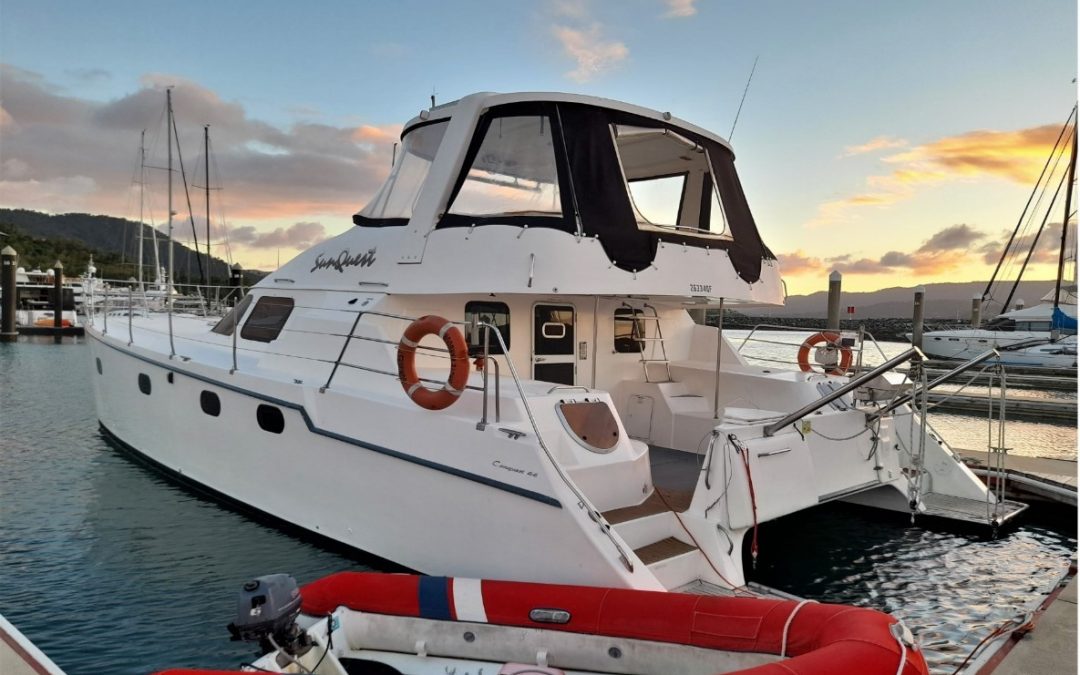Our caravan aficionados Jan and Peter (both 74) combine a caravan holiday with a cruise holiday, making the most of a Queensland getaway.
With winter approaching, the warmer weather in northern Queensland was looking attractive!
We decided to follow the Queensland coastline up as far as Airlie Beach and then hire a boat to cruise the Whitsundays. We told friends of the trip. The first thing they asked was, ‘Do you need a boat license?’ While our boating experience was useful, a license wasn’t a mandatory requirement. Yes, that’s right, you can hire a cruiser and not have a boating license!
Twenty-two years ago, we chartered a similar vessel in the Whitsundays, so we thought we would recapture fond memories, seeing as we can’t travel overseas.
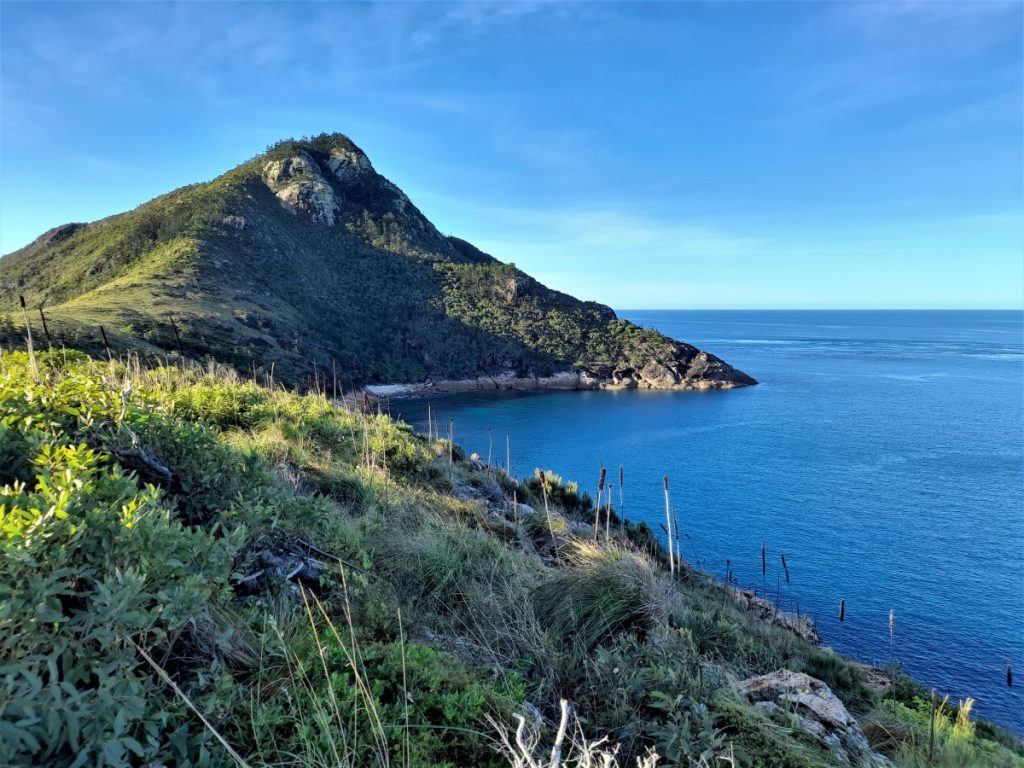
We spent a great week of caravanning from the Gold Coast to Airlie Beach. From here, we found the Whitsunday Yacht Charters’ office above the restaurants and tourist shops in the Coral Sea Marina. We viewed our vessel which would be our home for 8 nights. Sunquest is a 44 ft catamaran, twin engine motor cruiser. Beautiful.
Whitsunday Charters phoned to advise our vessel would be available from 2pm for boarding, which allowed us to be well settled in before our departure the following morning. We stocked up on groceries from Woolworths nearby.
For an extra fee, an additional night can be spent on the boat in the marina in a ‘sleepover’ (as they call it). With a separate company, we arranged secure parking for our vehicle and caravan.
A staff member came on board to acquaint us to the workings of the stove, fridge, water, bathrooms, gas and power while we were plugged into the marina power.
No grey water is allowed to be released while in the harbour. A key was provided for the marina bathroom facilities. We strolled along the boardwalk to Airlie Beach to purchase fresh seafood for our first dinner on board.
TRAINING
We were up early to greet our instructor who arrived at 8am. The 4-hour orientation for operating Sunquest was informative and very helpful. The very explanatory navigation book A Hundred Magic Miles was perused and explained. As the prevailing winds for the following week were predicted to be south-easterly, we were made aware that comfortable anchorages would be on the northern sides of the islands.
The charter company ensures that the hirer understands the operation and all functions of the vessel. This includes navigation rules, how to read charts and successfully navigate reefs, shallow areas and anchorages. Once the briefing is completed, the hirer is assessed while manoeuvring the vessel out of the harbour.
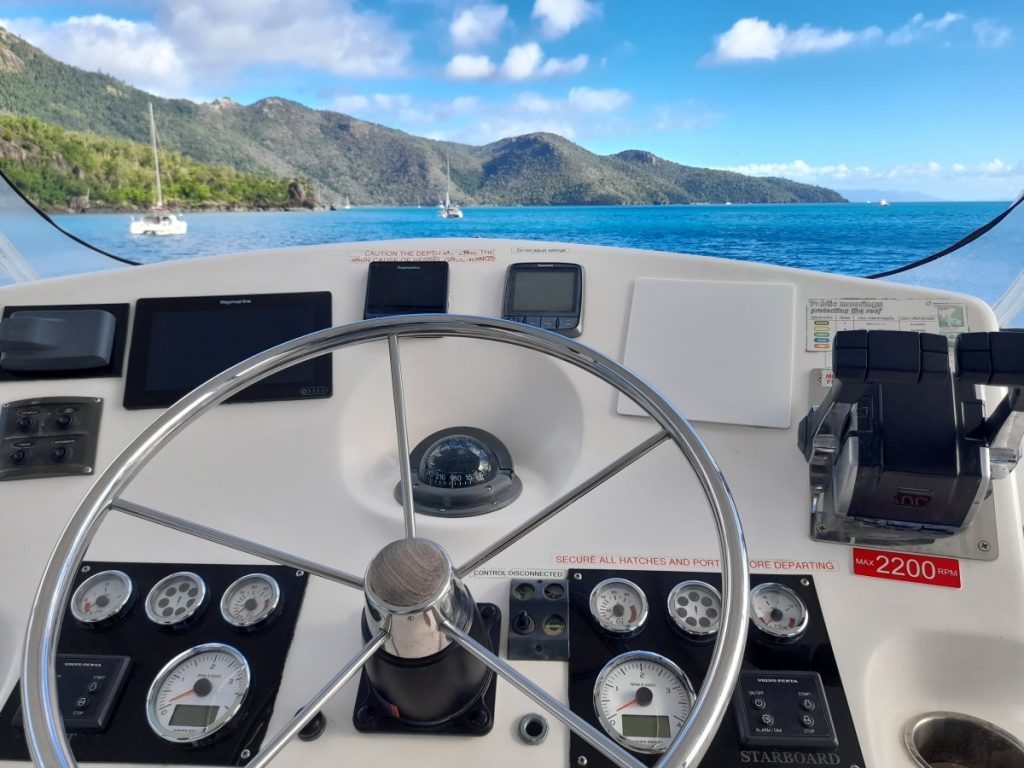
SKEDS
The hirers are required to make regular radio contact with the charter base. Two ‘skeds’ (scheduled radio contact) are compulsory each day with the charter base. The base will then give the hirers a forecast for weather, wind and sea.
At the 9am sked, the route for the day is reported. At 4pm the hirer advises their overnight anchorage. If an unsuitable mooring has been selected, they are required to move to a safe one.
Just outside the marina we were instructed on how to secure the boat to a mooring buoy and, alternatively, how to drop an anchor. Jan found retrieving the heavy mooring rope quite a challenge!
It is preferable to use mooring buoys where possible. This protects reefs from the damage caused by anchors. When no buoys are available anchoring further offshore is acceptable. Having satisfied our instructor, we returned him to the marina. Then, we were on our way!

WHITSUNDAY PASSAGE
We rounded Cape Conway and passed North Mole Island where we encountered choppy seas for our crossing of Whitsunday Passage to Hook Island. On the 3 June 1770 Lieutenant James Cook sailed into these waters. He named them in commemoration of Whitsun, which falls on the 7th Sunday after Easter.
Stonehaven was our overnight anchorage. There, Jan struggled with retrieving the heavy mooring rope from the buoy while dangling over the bow. We made our 4pm radio sked to advise the base that we were secure for the evening. It was a very restful evening in slight seas. A pink sunset enhanced our view across the water to Hayman Island and Langford Reef.
Mooring was the topic of conversation over breakfast. After our 9am sked to advise of our itinerary, we moved over to Langford Reef.
Jan extracted Peter from the captain’s seat while Peter caught, lifted and secured the mooring rope. This was a great improvement and we successfully continued to use this arrangement. As soon as we were settled, a school of large batfish swam right up to the rear duckboard and popped their faces out of the water to look at us. What a surprise! They are obviously used to being hand fed.
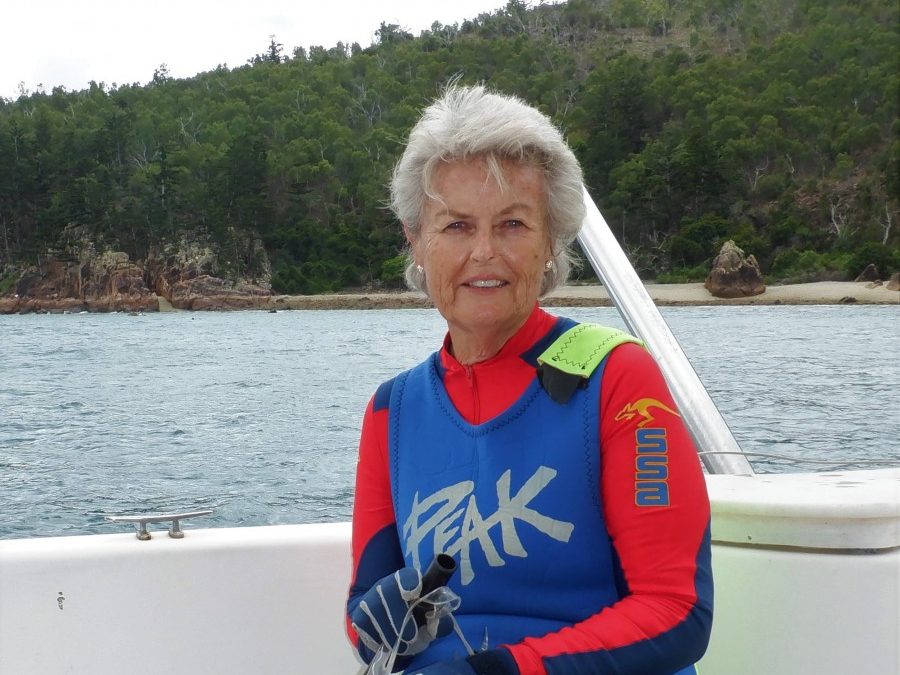
HAYMAN ISLAND
We made our lunch time anchorage Blue Pearl Bay on the northwest side of Hayman Island. We took the opportunity to snorkel on the reef. There were coral trout, parrot fish, batfish, and schools of tiny colourful fish.
Tropical cyclone Debbie made landfall in March 2017. Underwater we could see the trail of destruction she left on the coral. A tour group arrived, and we followed their lead to discover that the best coral and colorful fish were further offshore.
That afternoon we cruised around the northwestern tip of Hayman Island towards Hook Island and picked up a mooring buoy in Butterfly Bay. We launched the tender (a smaller boat used to get to shore) to explore the beach. At the northern end, we scrambled over rocks along a watercourse which, to our surprise, led to a waterfall. Although Butterfly Bay was named because of its shape, butterflies hovered all around us in the thick vegetation and ferns. We were back on board Sunquest in time to enjoy another lovely sunset.
UNDERWATER ADVENTURES
In perfect morning sunshine (after our regulatory 9am sked) the tender was launched. We motored to the other side of the Butterfly Bay to snorkel along the reef. The marine life on the large coral bommies was fascinating.
Further into the bay we spied a turtle and lots of coloured fish. Back on board, the tender was hoisted up at the stern. Our stinger protection suits were hung up to dry, and lunch devoured. (May is the very end of season when the Irukandji stingers can be found in these waters).
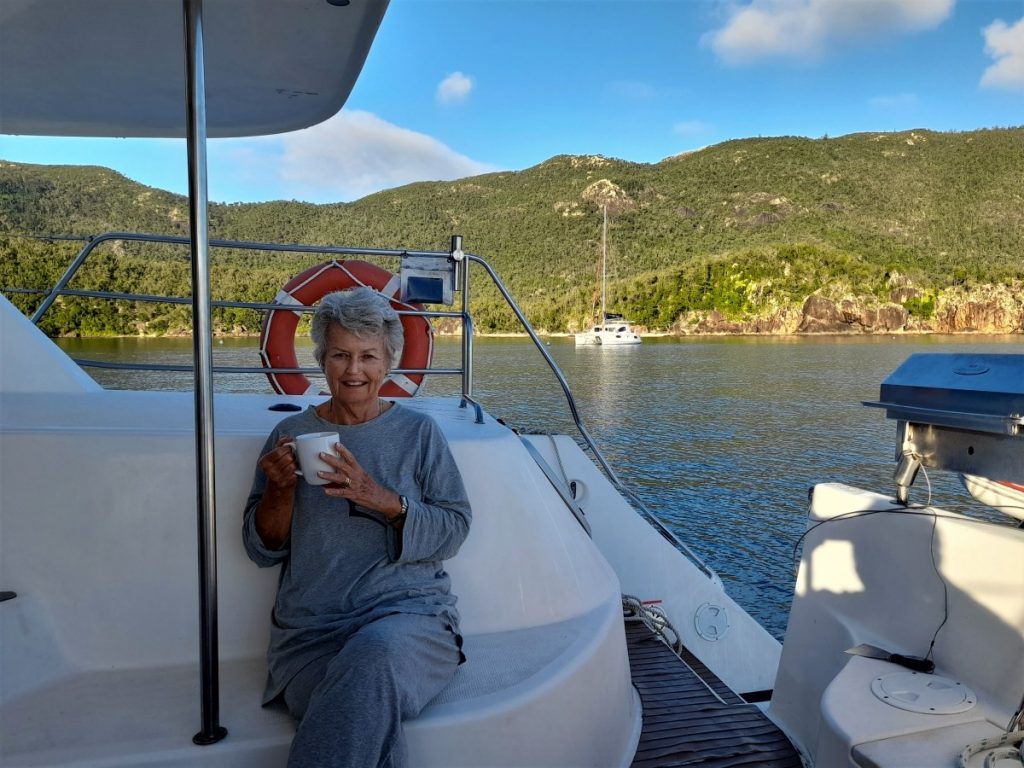
THE OUTER ISLANDS
We were on our way again. With the auto pilot set for Border Island out to the East, we enjoyed smooth water and fine weather for the hourand-a-half crossing in open seas. We picked up a mooring buoy in Cataran Bay, sheltered from the south easterly winds. An afternoon hike took us to Mosstrooper Peak to marvel at the views of the pretty bays below us as well as Deloraine, Whitsunday and Hazelwood Islands in the distance.
Strong south-easterly winds greeted us in the morning which meant we encountered a choppy crossing once we cleared the shelter of Border Island. We were headed for shelter in Tongue Bay on Whitsunday Island. This bay is very popular with tourist boats. Luckily, we managed to hook one of the last available buoys.
The walk along the forested paths took us to lookouts over the spectacular Whitehaven Beach and Hill Inlet. The harvesting of hoop pines took place here from the late 1800s to early 1900s. Sawn timber was shipped to the mainland.
In a falling tide, a fellow tourist helped us pull the tender off the beach enabling us to return to Sunquest for lunch. We cruised along the length of Whitehaven and inside Lagoon Rock to one of the last available mooring buoys at Chalkies Beach, Hazelwood Island. Ashore, we enjoyed a short climb up stairs to the lookout. We could see Whitehaven, Martin Islet and the Solway Passage. This is the main route for boats which transport tourists from Hamilton Island to Whitehaven Beach. Sheep had grazed on Hazelwood Island in the 1930s. It was declared a National Park in 1940.
Back on board and on the flybridge for the 4pm sked, we relaxed with our favorite drink. It was a wonderful calm mooring but, in the morning, a strong current made snorkelling too much of a challenge. We moved Sunquest to the northern end of Chalkies Beach, swam out against the current and drifted slowly back enjoying the marine life along the drop off.
We later took the tender to explore along the northern side of Hazelwood Island. Our goal was Windy Bay where we spent a lovely day 22 years ago. We anchored the tender near the headland at the entrance to the shallow bay and again loved strolling along this deserted beach, exploring all the nooks and crannies and a small creek. We searched for the track that previously led over the island to a reef on the other side. But alas, the track was now overgrown.
On our return journey we walked the tender through shallow crystal-clear blue waters with a cute island just offshore. There was a lovely beach on the headland at Katies Cove, to the north of Chalkies. We had an impressive view of the edge of the reef as we slowly motored back over it to Sunquest.
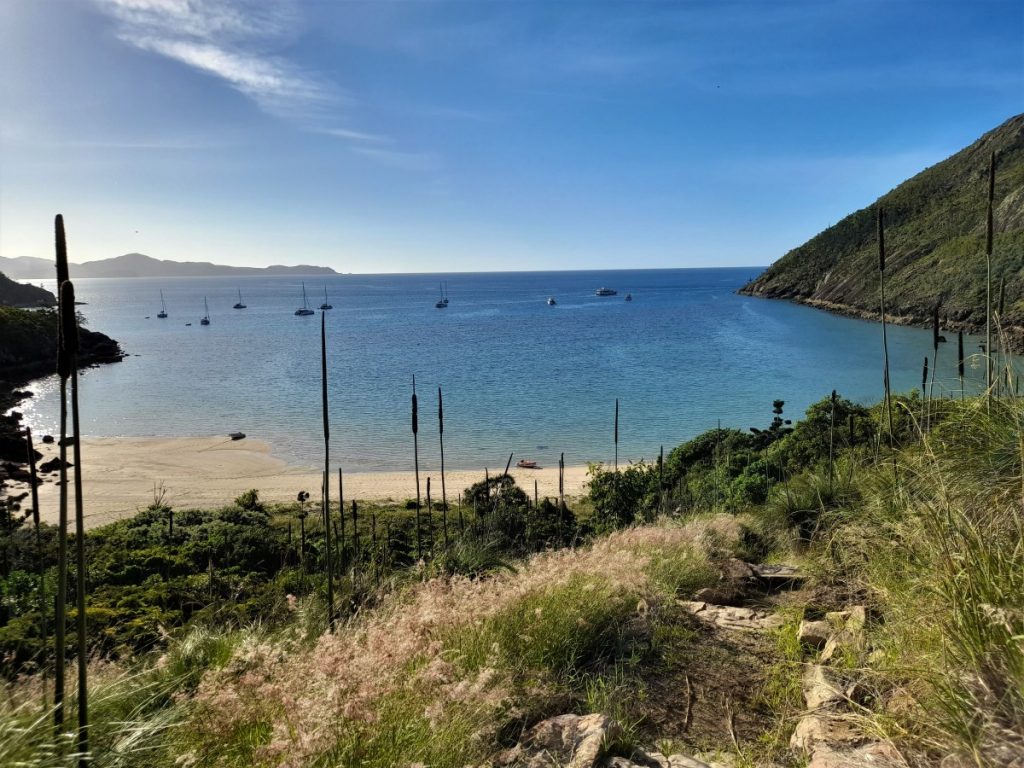
THE ESSENTIALS
Running the engines for a minimum of 4 hours each day is enough to charge the batteries. As a result of motoring for a very short time the previous day, our power and hot water supply were low. We took off at 7.30am and cruised the long way around the eastern side of Border Island to recharge the batteries. The high cliffs and small sheltered bays along the island were lovely. We did our morning sked while cruising in calm open seas.
MORE EXPLORATION
On Hook Island we moored in Saba Bay. With a fringing reef here, we made a very cautious entry. What a delight to find we had the bay and pretty coves all to ourselves. The tender took us to the end of the bay for an interesting snorkel out towards the drop off. We decided to move on after lunch because of the falling tide and shallow reefs at the entrance to the bay.
Cairn Bay, on Whitsunday Island, was our evening anchorage. Just across the Passage was the beach which once housed the Hook Island Underwater Observatory. It was a tourist attraction constructed in 1966 but, it was closed because the submarine viewing chamber had insufficient ventilation. Since its closure it has fallen into disrepair.
With the tender secured on Cairn beach, we explored the shoreline and a campground nearby. The currents and wind swung us backwards and forwards in the evening. This caused the buoy to bang against the hulls, disturbing our sleep, despite us freeing it a couple of times. In the morning we noticed a nearby yachtie had pulled his buoy up above the water. We wondered why we hadn’t thought of that.
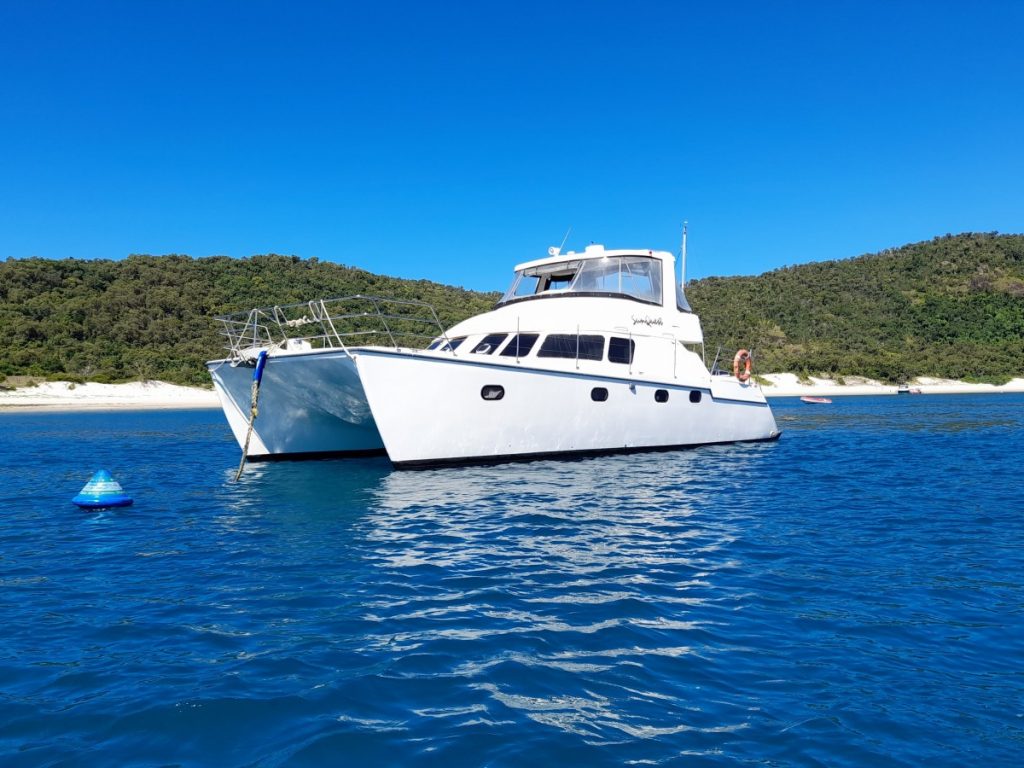
On Mother’s Day, we were fortunate to be in phone range and Jan was able to answer greetings from our family. With the tender on shore, we snorkeled straight off the beach. It was at the top of the tide allowing a lovely snorkel with no current. We swam out as far as the drop off which was the best viewing on this journey. Again, there was cyclone damage, no staghorn or branch corals, but coral bommies, schools of fish and soft corals.
After negotiating the swirling currents at the entrance to Hook Passage, we travelled up the eastern side of the island. Luncheon Bay on the northern side offered a sheltered spot, appropriately, in this pretty area for lunch. A passage between Hayman and Hook Island led to Stonehaven where we hooked on one of the few vacant buoys for the evening. It was protected from strong winds.
On our last morning we departed at 7.30am entering choppy seas until we rounded North Molle Island. A radio call on approach to Airlie Beach brought two deck hands on board as we arrived in the harbour for a condition report, refueling and a debrief. Our fuel bill was surprisingly only $187.00!
Our car was waiting for us at the marina. We collected our caravan, and enjoyed the next week travelling south along the Australian Country Way towards the Gold Coast and home. Another caravan adventure awaits!
Want to hire a boat like Jan and Peter? Then check out whitsundaysyachtcharters.com.au.
Check out other caravan adventure locations you can go to in this article.

Editor for Silver Magazine Gold Coast
